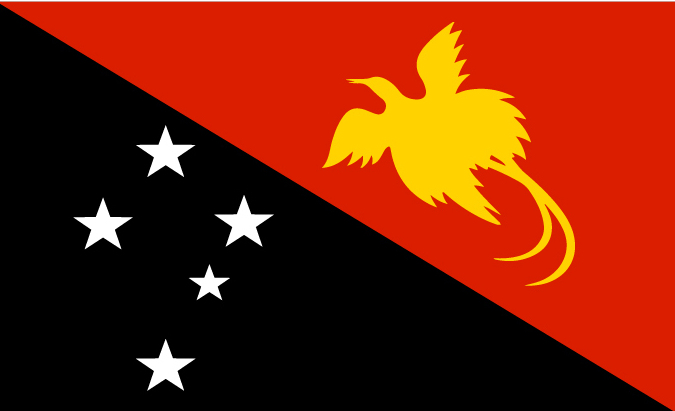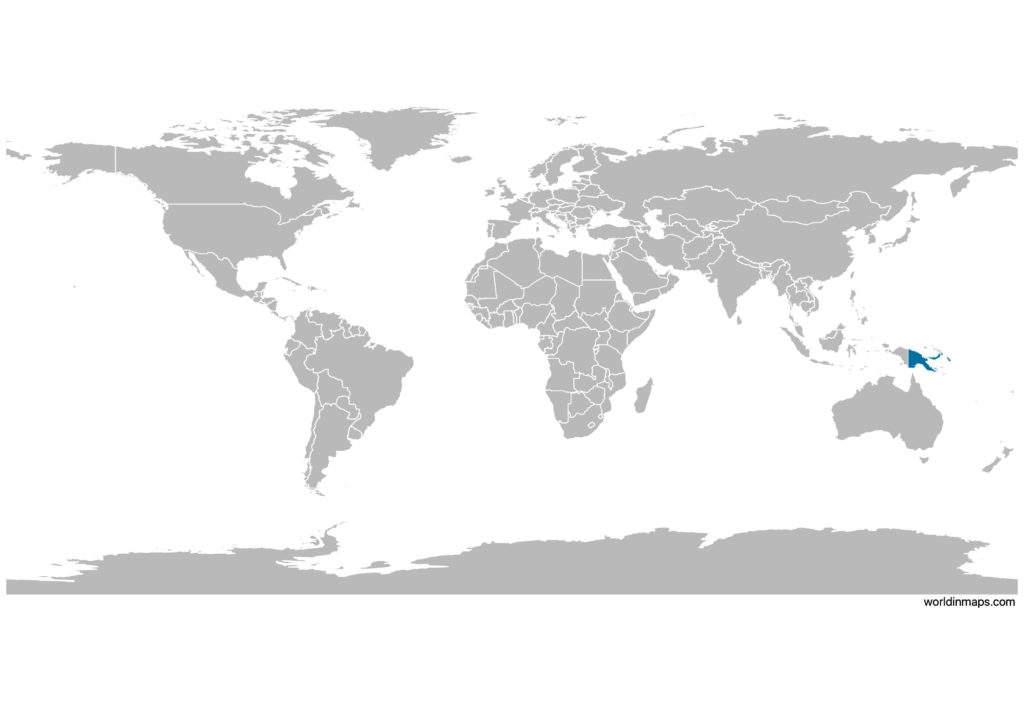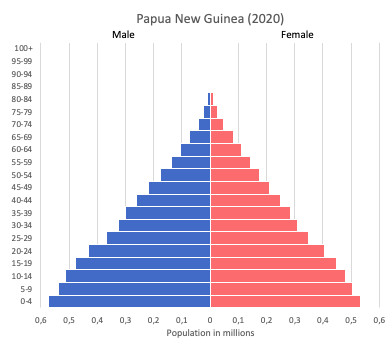Papua New Guinea

| Government | |
| Name | Independent State of Papua New Guinea |
| Tok Pisin | Independen Stet bilong Papua Niugini |
| Hiri Motu | Independen Stet bilong Papua Niu Gini |
| Government type | parliamentary democracy under a constitutional monarchy (a Commonwealth realm) |
| Capital | Port Moresby (283,733) |
| Currency | Papua New Guinean kina (PGK) |
| Organization | |
| Member State | Commonwealth of Nations |
| People | |
| Population (2020) | 8,947,027 (98th) |
| Density of population | 15 P/km2 (201st) |
| Nationality | Papua New Guinean |
| Official languages | |
| Tok Pisin | |
| English | |
| Hiri Motu | |
| Note: some 839 indigenous languages (about 12% of the world’s total) and many languages have fewer than 1,000 speakers | |
| Ethnic groups | |
| Melanesian | |
| Papuan | |
| Negrito | |
| Micronesian | |
| Polynesian | |
| Religions (2011) | |
| Protestant | 64.3% |
| Evangelical Lutheran | 18.4% |
| Seventh Day Adventist | 12.9% |
| Pentecostal | 10.4% |
| United Church | 10.3% |
| Evangelical Alliance | 5.9% |
| Anglican | 3.2% |
| Baptist | 2.8% |
| Salvation Army | 0.4% |
| Roman Catholic | 26% |
| other Christian | 5.3% |
| non-Christian | 1.4% |
| unspecified | 3.1% |
| Life expectancy (2020) | |
| Male | 65.6 years |
| Female | 70 years |
| Total population | 67.8 years (179th) |
| Homicides | |
| Total (2010) | 9.8 per 100,000 people (37th) |
| Geography | |
| Land area | 452,860 km2 |
| water area | 9,980 km2 |
| total area | 462,840 km2 (56th) |
| Mean elevation | 667 m |
| Lowest point | |
| Pacific Ocean | 0 m |
| Highest point | |
| Mount Wilhelm | 4,509 m |
| Land use (2011) | |
| Agricultural land | 2.6% |
| Arable land | 0.7% |
| Permanent crops | 1.5% |
| Permanent pasture | 0.4% |
| Forest | 63.1% |
| Other | 34.3% |
| Urbanization | |
| Urban population (2020) | 13.3% |
| Rate of urbanization | 2.51% annual rate of change (2015 – 2020) |
| Economy | |
| Labor force (2017) | 3.681 million (97th) |
| Labor force by occupation | |
| Agriculture | 85% |
| Industry | NA |
| Services | NA |
| Unemployment rate (2017) | 2.5% (26th) |
| GDP (PPP) (estimate 2019) | |
| Total | $32.382 billion (124th) |
| Per capita | $3,764 |
| GDP (nominal) (estimate 2019) | |
| Total | $21.543 billion (110th) |
| Per capita | $2,504 |
| GDP by sector (estimate 2017) | |
| Agriculture | 22.1% |
| Industry | 42.9% |
| Services | 35% |
| Exports (2017) | $8.522 billion (95th) |
| Exports partners (2017) | |
| Australia | 18.9% |
| Singapore | 17.5% |
| Japan | 13.8% |
| China | 12.7% |
| Philippines | 4.7% |
| Netherlands | 4.2% |
| India | 4.2% |
| Imports (2017) | $1.876 billion (170th) |
| Imports partners (2017) | |
| Australia | 30.1% |
| China | 17.3% |
| Singapore | 10.2% |
| Malaysia | 8.2% |
| Indonesia | 4% |
Papua New Guinea on the world map

Papua New Guinea top 10 largest cities
- Port Moresby (283,733)
- Lae (76,255)
- Arawa (40,266)
- Mount Hagen (33,623)
- Popondetta (28,198)
- Madang (27,419)
- Kokopo (26,273)
- Mendi (26,252)
- Kimbe (18,847)
- Goroka (18,503)
Demography
Population pyramid

Age structure data
Estimate for 2020:
- 0-14 years: 31.98% (male 1,182,539/female 1,139,358)
- 15-24 years: 19.87% (male 731,453/female 711,164)
- 25-54 years: 37.68% (male 1,397,903/female 1,337,143)
- 55-64 years: 5.83% (male 218,529/female 204,717)
- 65 years and over: 4.64% (male 164,734/female 171,916)
Remark: the age structure of a population affects a nation’s key socioeconomic issues. Countries with young populations (high percentage under age 15) need to invest more in schools, while countries with older populations (high percentage ages 65 and over) need to invest more in the health sector. The age structure can also be used to help predict potential political issues. For example, the rapid growth of a young adult population unable to find employment can lead to unrest.
Population from 1950 to 2020
Source: United Nations, Department of Economic and Social Affairs, Population Division (2019). World Population Prospects 2019, Online Edition. Rev. 1.
Evolution of the life expectancy from 1960 to 2018
Source: World Development Indicators, The World Bank
Economy
Agriculture:
coffee, cocoa, copra, palm kernels, tea, sugar, rubber, sweet potatoes, fruit, vegetables, vanilla; poultry, pork, shellfish
Industries:
copra crushing, palm oil processing, plywood production, wood chip production, mining (gold, silver, copper), crude oil and petroleum products, construction, tourism, livestock (pork, poultry, cattle), dairy products, spice products (turmeric, vanilla, ginger, cardamom, chili, pepper, citronella, and nutmeg), fisheries products
Exports – commodities:
liquefied natural gas, oil, gold, copper ore, nickel, cobalt logs, palm oil, coffee, cocoa, copra, spice (turmeric, vanilla, ginger, and cardamom), crayfish, prawns, tuna, sea cucumber
Imports – commodities:
machinery and transport equipment, manufactured goods, food, fuels, chemicals
Time zone and current time in Papua New Guinea
Go to our interactive map to get the current time in Papua New Guinea